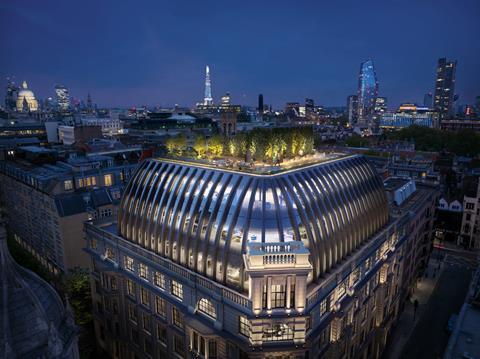Is retrofit just a buzzword and an oversold solution for reaching sustainability goals? Not if we can avoid using excessive amounts of steel or diverting high amounts of material to landfill when we repurpose our buildings, writes Mark Swetman.

Too often, the challenges of retrofitting discredit it as a plausible sustainability solution. This point could be valid if there were not a significant shift in the way we support and deliver retrofit. At 5 Chancery Lane, we at LS Estates are demonstrating how these challenges can be overcome and outweighed by embedding a circular approach that favours a long-term economic return.

For the right reasons, the built environment is being scrutinised and constantly challenged to develop innovative solutions to reuse, repurpose and recycle. However, traditional construction methods are not adapted to our current system, and there is no time to waste to meet the Climate Action Strategy set by the City of London.
This year, thousands of offices across the country have become unlettable as a result of the new net zero rules and landowners are now either facing expensive renovation work to bring their buildings up to standard or having to sell their assets.
As a sector, there is much more that we can do to increase retrofit efficiency as a solution to meet climate goals
While retrofit has become increasingly popular in recent years, it has come under scrutiny. The retrofit concept has been around for decades but is impeded by misaligned incentives, poor regulations and economic and technological barriers.
As a sector, there is much more that we can do to increase retrofit efficiency as a solution to meet climate goals. The use of alternative materials and driving a sustainable approach are examples of the latest initiatives that we can apply when considering retrofit to deliver a building with higher value.
This is not theoretical or wishful thinking. 5 Chancery Lane, an early 1900s building which is being substantially reconfigured and extended into a 100,000ft2 modern office space, is a live case study.
The comprehensive plan for the project includes the retention and reuse of 86% of the original building, reducing demolition and high carbon materials while creating a new roof structure on floors five, six and seven. The distinctive new curved glazed roof will sit on the retained structure, with the new lightweight floors being supported by a unique close-centred perimeter necklace of curved laminated timber columns, eliminating the need for vertical structural columns through to the foundations.
However, the use of timber in commercial buildings brings its own challenges, from increased material costs to regulatory restrictions and financing. The industry has been slow to adapt to and understand the benefits and opportunities of timber in construction. This transition in understanding needs to gather pace.
>> Also read: Government outlines roadmap to increase use of timber in construction
Furthermore, retrofitting has a key role to play in reducing future energy demand, but the longevity and resilience of the materials used need to be considered. Another criticism pointed at the retrofit processes is the production of high-carbon waste and creating buildings that are difficult to upgrade.
A circular economy aims to keep the materials at the “highest value possible”, meaning materials are maintained in their original state or near original state, for as long as possible. 5 Chancery Lane decided to follow this approach in order to avoid excessive amounts of waste. Overall, the redevelopment will save 4,800 tonnes of carbon dioxide emissions and divert 98% of construction waste from landfill.
It is also important to consider the building’s lifecycle to understand its true carbon impact. The Whole Life Cycle Carbon assessment provides an excellent opportunity for retrofits to shine, frequently outperforming new-builds in reducing emissions during both the production and operational stages.
The retention of the existing building – from substructure and superstructure to internal-external walls and windows – could reduce a scheme’s overall carbon footprint by 75% from its current position. This translates into an improved lifetime resource efficiency, reduced costs and future-proofing the asset’s value.
We must raise awareness among developers about the long-term economic return from long-lasting retrofitted buildings
The UK’s retrofitting industry will have to grow by a factor of 10 for the country to meet its net zero targets, and both regulatory and financial support will need to evolve rapidly for this to be achieved. Developers must also quickly realise the potential of retrofitting as a long-term solution and align their business and operations for the future.
We have demonstrated how to keep circular materials at their highest value, but the lack of retrofit and supply chain skills hinders implementation at scale. Hence, we must encourage developers and the public sector to choose sustainable retrofit to facilitate a retrofit economy.
Let’s remember that retrofit is about anticipating our future needs and we must raise awareness among developers about the long-term economic return from long-lasting retrofitted buildings. While UK policy and financial incentives supporting retrofits are severely lacking, the inevitable emergence of green bonds, government grants and enhanced capital allowances for energy-saving technologies will make retrofits more affordable.
Lastly, the acceleration of introducing financial tools and incentives is fundamental and the proactive engagement of developers, investors and contractors is essential. A collective effort will speed up the real estate sector’s shift towards sustainability, fostering a more eco-friendly industry.
Mark Swetman is managing partner at LS Estates, a development company specialising in central London



























No comments yet